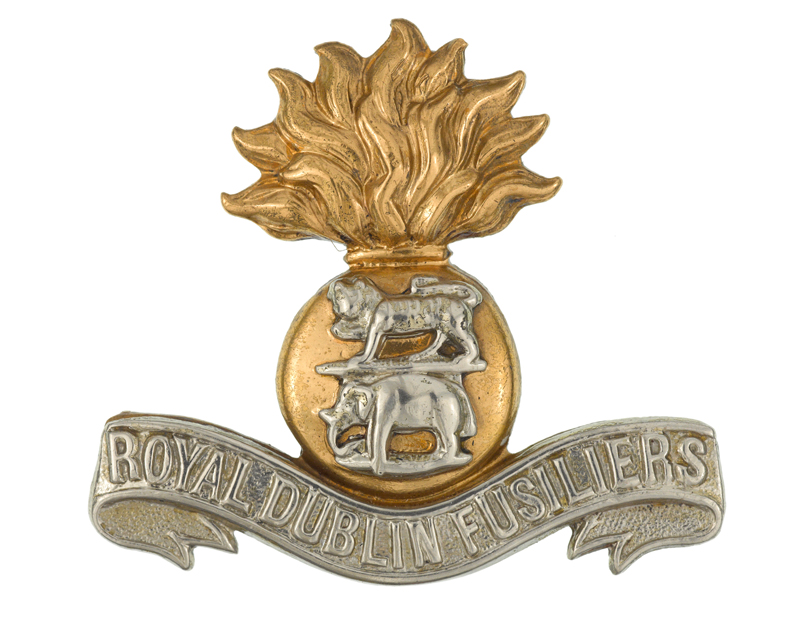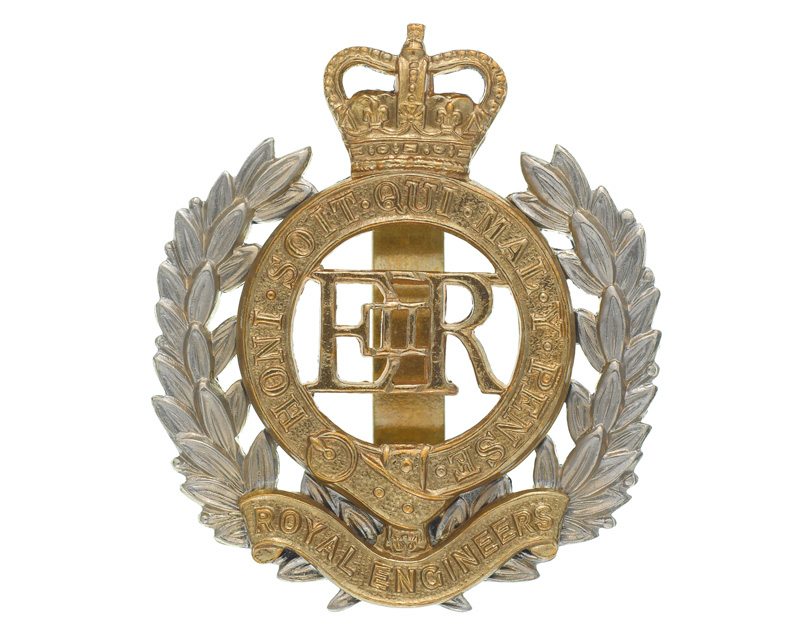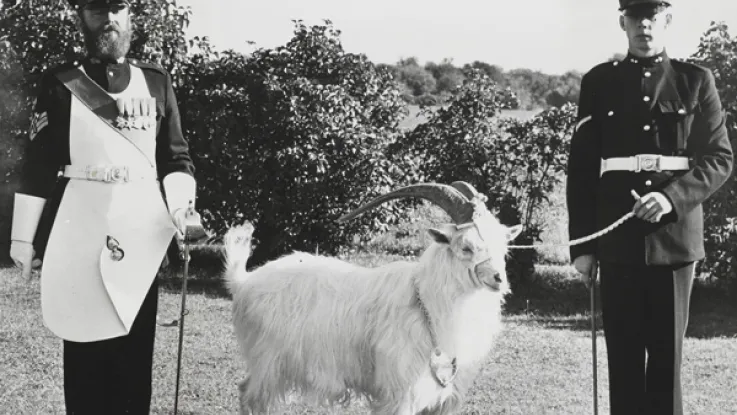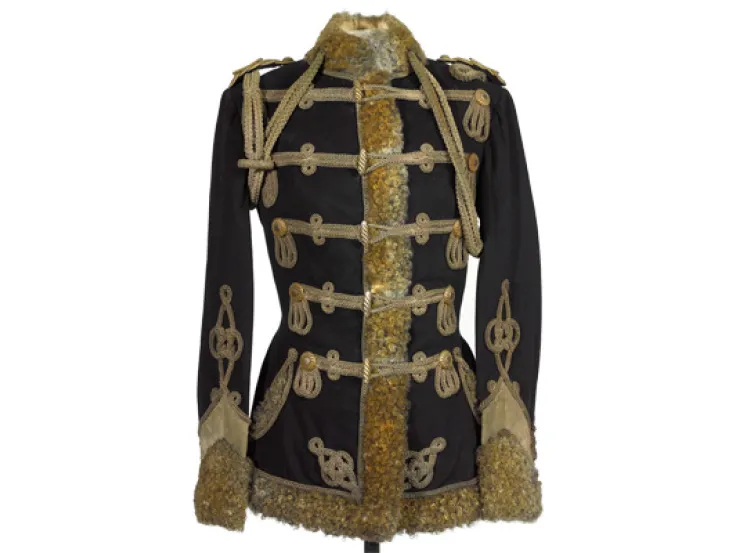Symbolic links
Soldiers wear a badge on their uniform headdress as a way of identifying the regiment or corps to which they belong. Many badges feature symbols that are important to the unit. These might include links to a sovereign or royal dynasty, the regiment’s city or county origins, or a famous battle honour.
Originally, the colonel of a regiment could put whatever device he chose onto his soldiers’ headdress. But things became more regulated from the mid-1700s. Since then, the design of regimental badges has been controlled by the Army’s high command.
Names, numbers and places
The most distinguishing feature of a headdress badge is the name (or sometimes just the number) of the regiment. By the early 1700s, units were increasingly being referred to according to their number or rank in the order of precedence, which usually reflected the date the unit had been raised – the older the regiment, the lower the number. This was despite the fact that most regiments were officially named after their colonels.
In 1751, a royal warrant stated that regiments should be known only by their numbers. For example, the unit that had originally been raised as the Duke of Norfolk's Regiment of Foot became officially known as the 22nd Regiment of Foot. The warrant added: ‘No Colonel is to put his Arms, Crest, Device, or Livery on any part of the Appointments of the Regiment under his Command.’
Although the numbering changed over the years as units were disbanded and new ones were raised, the numeric approach to regimental names continued through to the Victorian era. This resulted in numerals being the most common feature of headdress badges during that time.
County affiliations started to make their way into regimental names from the late 1700s, but it wasn’t until the Childers Reforms of 1881 that numbers were abandoned, largely in favour of names that demonstrated these geographical ties. During this period, the 22nd Regiment of Foot, for example, became known as the 22nd (Cheshire) Regiment of Foot, before officially becoming The Cheshire Regiment in 1881. As regiments’ names became less formulaic, so too did their badges.
Headdress regulations
Badge designs have varied depending on the type of headwear on which they appear. During the 1800s, there were several changes to uniform regulations, which affected the badges worn by soldiers of different ranks and from different branches of the Army.
The shako, introduced in 1800, was the first regulation form of headdress. Although it evolved over the next century, it was quite bulky and carried a correspondingly large shako plate depicting the regimental insignia. In 1844, a garter (or belt) was added to the basic design of the shako plate displaying the regimental name or motto around the central number.
Forage caps were first officially regulated in 1811, although their regimental use pre-dates that. They were a smaller form of headwear, featuring smaller cap badges. By the Crimean War (1854-56), they were widely seen as a more practical alternative to the shako.
The glengarry was the equivalent to the forage cap for Scottish regiments. By 1874, other ranks throughout the Army had adopted this style of headwear. Twenty years later, infantry regiments switched to the new field service cap, although Scottish regiments continued to wear the glengarry.
The need for smaller badges for the field service cap had a major impact on badge design. Initially, it was suggested that collar badges should be repurposed for the new caps. But, coming soon after the large-scale reforms of the 1870-80s, regiments now had the impetus and opportunity to create their own unique insignia, drawing on traditions from their past service and local history.
There were more changes over the course of the 1900s - including the introduction of the beret and further variations in the materials used - but none had so significant an effect on the design of headdress badges.
Roles
Some of the symbols commonly found on headdress badges reflect regimental roles (either current or historical).
One example is the stringed bugle horn, used by light infantry and rifle regiments. These fast-moving infantry units traditionally relied on bugles instead of drums for battlefield communications as they were less cumbersome to carry.
The badge of the Corps of Royal Electrical and Mechanical Engineers includes a lightning flash. This symbolises electrical engineering, while the chained horse symbolises power under control.
Regimental roles are also reflected by types of weapon or equipment. The badge of the Royal Pioneer Corps, for example, displays the unit’s traditional tools of the trade: the rifle, shovel and pick. And lancer regiments often feature lances on their insignia.
The flaming grenade that is commonly seen on the headdress badges of fusilier regiments and the Grenadier Guards does not reflect any shared grenade-throwing heritage. It is more a mark of distinction, grenadiers having traditionally been regarded as elite troops.
The Grenadier Guards - previously the 1st Regiment of Foot Guards - were only given their new name and badge in 1815 after defeating the French Grenadiers at Waterloo. The symbol has also featured on the insignia of the Royal Artillery and Royal Engineers, although not on their headdress badges.
Battle honours
Battle honours appear on headdress badges in various guises. Sometimes, they are simply referenced in text above or below the main design. On other occasions, for greater emphasis, they appear symbolically as the central motif.
One example is the castle and key, representing the Great Siege of Gibraltar (1779–83). Another is the sphinx, symbolising the Egyptian campaign of 1801. Soldiers of the 28th Foot (and its successor unit, the Gloucestershire Regiment) were granted the unique distinction of wearing the sphinx at the back of their headdress in commemoration of their back-to-back stand at the Battle of Alexandria. Tigers and elephants tend to reflect service on the Indian subcontinent.
Royal crowns and cyphers
Crowns are another feature commonly seen on regimental insignia. Different styles of crown represent different periods of history, so this can be a way of dating a badge. The main types are: the Victorian Crown – 1837-1902; the King’s Crown (also known as the Tudor Crown) – 1902-1953; and the Queen’s Crown – post-1953.
Royal cyphers are less common than crowns on headdress badges, but allow more accurate dating as they relate to individual monarchs.
Different styles of coronet have also been used to demonstrate links to a particular member of the royal family, including the Prince of Wales (whose coronet is usually accompanied by three ostrich feathers).

Royal Engineers cap badge with Victorian Crown and royal cypher of Queen Victoria, c1900

Royal Engineers cap badge with King's Crown and royal cypher of King George V, c1914
Stars and crosses
An eight-pointed rayed star was introduced as the basic shape of the shako plate in 1829. It was later replaced by a laurel wreath, but continued to be used by some regiments as part of their cap badge designs.
Other forms of star (some with different numbers of points) have also been used. To this day, the stars of the Orders of the Garter, St Andrew and St Patrick appear on the cap badges of the Coldstream Guards, Scots Guards and Irish Guards respectively.
In 1878, the cloth helmet was introduced for infantry regiments. Helmet badges came in three styles: the Brunswick Star, the Royal Arms, and the Maltese Cross. The Maltese Cross continued to be used elsewhere, including on the cap badges of certain rifle regiments.
National symbols
Another type of cross that is used by several regiments is the saltire of St Andrew. Along with thistles, rampant lions and the figure of St Andrew himself, this symbol demonstrates a regiment’s association with Scotland. Similarly, regiments with Irish origins tend to use emblems such as harps and shamrocks.
Myth and legend
Some regiments have adopted symbols from national legend or classical mythology.
The Northumberland Fusiliers had a cap badge featuring the legendary figure of St George killing a dragon. The regiment was permitted to use this ‘ancient badge’ in uniform regulations dating back as far as 1747. It still appears on the badge of its successor unit, the Royal Regiment of Fusiliers, which was formed on St George's Day 1968.
The badge of the Seaforth Highlanders depicts a stag with the motto 'Cuidich 'n Righ' (‘Aid the King’). According to legend, this motto originated from a 13th-century hunting incident, when the chief of Clan Mackenzie rescued King Alexander III of Scotland from a wounded stag. The Seaforth Highlanders inherited the motto from the 72nd Foot, which had been raised in 1778 by the Earl of Seaforth, a member of the clan.
The Royal Army Dental Corps badge includes a dragon's head, with a sword in its mouth, and the motto 'Ex Dentibus Ensis'. This translates as 'From the teeth, a sword' and refers to an Ancient Greek legend. Cadmus, a mythical king and founder of Thebes, is said to have buried the teeth of a slain dragon only for a host of armed men to spring suddenly from the ground.
Badges today
Badges continue to evolve as new regiments are formed. Many of today’s regiments have clearly demarcated recruiting areas, some of which are given symbolic representation in their insignia.
The Yorkshire Regiment and the Duke of Lancaster’s Regiment, for example, reflect their local ties through the white and red roses of York and Lancaster respectively, symbols inherited from antecedent units.
The badge of the Mercian Regiment is an interesting case. It depicts the Mercian double-headed eagle with a Saxon crown. Mercia was an Anglo-Saxon kingdom that covered the English Midlands from the 6th to 10th centuries. This archaic emblem was chosen as it reflects the full extent of the unit’s diverse recruiting area in a way that more recent symbolic connections cannot.







































